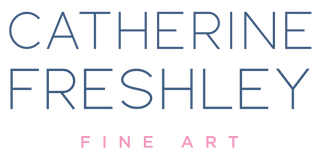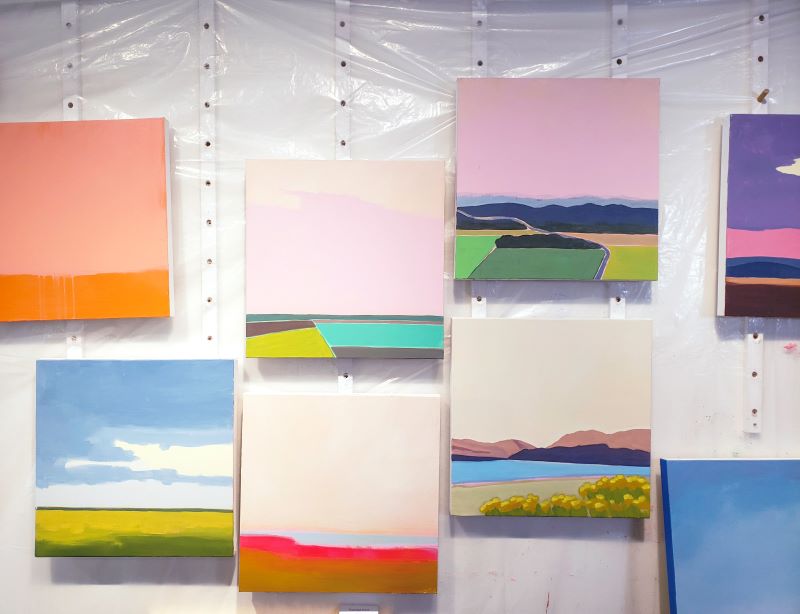Pricing: A How-to for Artists Just Starting Out

Pricing has been one of the hardest things for me as an artist and I know it’s hard for others, especially when they are first starting out. In the interest of helping other artists, I thought I would share a bit about my pricing structure. Maybe this is poor form, maybe collectors aren’t supposed to know what’s under the kimono, but I’ve benefited a lot from other artists sharing their knowledge and I like transparency.
It is commonly advised to price based on size and (with rare exception) to price all paintings of any given size the same. I follow this advice. Sure, you may like one 30”x40”painting more than another 30”x40” and one may have taken longer than the other, but prospective buyers don’t know that – and don’t need to. Seeing price discrepancies on two paintings that are the same size and caliber will confuse them and may make you look untrustworthy and unprofessional.
My first step in developing my pricing was to set the price for an 18”x24” painting. It is roughly in the middle of the sizes I paint and it is popular with my buyers. My other prices are based off this first price; as such, this step is the hardest and most important.
This price is based off several factors and you can find equations galore about summing materials cost, labor, overhead, profit, and then multiplying by two, etc. I’m not going to lie – I’m not quite that organized with my expenses and didn’t set this first price off any such formula.
Expenses: I know how much a canvas costs (a lot), I know how much paint costs (a lot), I know how long my paintings take me (a long time) and what kind of hourly wage I want to make (something I can actually live on), how much Facebook ads cost and business cards, and how much time I spend managing my Instagram and responding to email inquiries and going to festivals, etc., so I take all those things into account. For me, that’s kind of the ‘duh’ part. Even if you’re really, really just starting out and selling art as a hobby, you definitely need to cover your expenses and, ideally, your time.

Competition: You also need to know what other artists at your skill level and with a similar level reputation are selling their work for. Look at festivals, look at coffee shops, look at galleries, look online. Study up. Figure out what a reasonable range is. Of course, having the lowest price is not the answer to selling more. In fact, if your art is priced too low, potential buyers may think there is something wrong with it. Everyone is always suspicious of something that seems too good to be true. Also, if they are trying to invest in art or just want to feel proud of the new painting they have on their wall, that feeling is not going to be based on having bought the cheapest thing they could find.
Confidence: This might be the hardest part. You need to feel good about your prices. You need to be excited to sell the painting at that price and you need to be excited for the client to get the painting at a fair price. You need to be able to tell someone the price of your painting without hesitation. Without adding, sheepishly, “I mean, the canvas itself was $60!” This part is SO hard. So many times, I’ll look at a painting and say, “Damn right that’s a good painting that should cost $500!” The next minute, I’ll turn around, look at again and say, “Who am I to think I could charge $500 for that little painting? I’m not in that league.” Constant battle. I’m not saying you should positive self-talk your way into high prices. Go back to those first two components (expenses and competition). Know the true value of your work and when you land on your prices, own them.
So…let’s say you’ve set that first price. Next, calculate what that comes to as a price per square inch. When I first did this a couple years ago, I decided I wanted to sell my 18”x24s” for $250. That felt like a good price for my skill level, my history of selling and I knew I was definitely covering my material costs. That comes out to be about 58 cents per square inch. If you want all your paintings to be the same price per square inch, boom! You’re done. Just multiply each size’s total square inches by whatever that price per square inch is.
But, I didn’t like that approach. I figure every painting has some fixed costs that don’t change based on its size. You have to drive to the store or order the canvas online (please tell me you’re buying in bulk to save money and time) and it doesn’t matter whether that canvas is 5” or 5’ – that time cost of acquiring the canvas is the same. Also, let’s say you paint from photos of landscapes, like me. You have to go out and get those photos, or have that inspiration and again, it doesn’t matter if you’re painting something tiny or huge, it still took an hour of sitting in your car watching the clouds to get that perfect photo. And then there is the mental courage of walking into your studio and opening up that first tube of paint.
All that to say, I increased my price per square inch for my smallest paintings. Do this in Excel so it’s easy to just try different numbers in your calculations. You can play with the numbers until you get prices you like. Or, set the price for your smallest painting by saying, “You know it’s really not worth it for me to sell something for less than X.” Then, use that price per square inch as your small-painting number.
The opposite is true with my biggest paintings; historically, I have given a pretty big “volume discount” – the price per square inch goes down substantially on the big guys (but I'm changing that). You can decrease price per square inch linearly or you can have a couple or few prices per square inch: one for your smallest sizes, one for your middle sizes and one for your largest.





Leave a comment